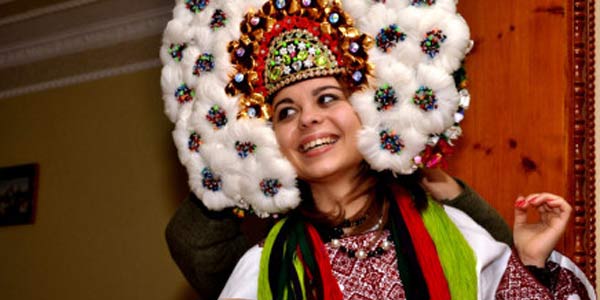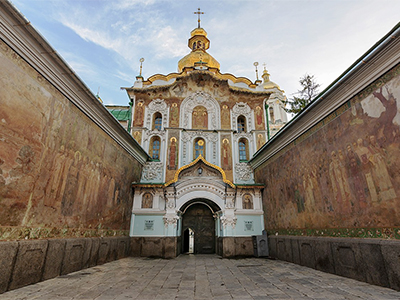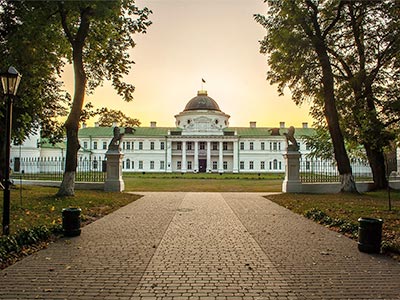 03.05.2018
Carpathian bridal chaplets of goose feathers
03.05.2018
Carpathian bridal chaplets of goose feathersChaplet of goose feathers made by the master Paraska Kushliak is truly a unique thing.
Could anyone outdo Brazilian carnival dancers? Easily! Such headdresses being made long since in the Carpathian village Velyky Kliuchiv are to be considered a work of art. The chaplets of goose feathers are truly a unique thing. They combine ancient Hutsul marriage traditions and original decorations.
Such chaplet weighs almost a kilogram. We visited the master and even tried on the ancient wedding clothes and headdress.
Once the wedding took place from Monday to Tuesday, and sometimes even from Tuesday to Wednesday. Bride’s mother previously ordered the bridal chaplet by a plaiter (and sometime in Kliuchiv there were several plaiters).
On the first day, before the wedding, the master came to the bride and dressed her. All bride’s hair was gathered on her head in a lock, then two small hair locks were separated, tied, greased with honey and fixed in form of “fly” (as this hair was called). Then embroidered stripes were put on those “flies” and next large strips called “uplitka” were set. Each element of the chaplet was dressed separately, so that the process of bride’s dressing lasted at least two hours.
On the wedding day the bride went to marriage with the chaplet and untressed hair. By the way, also bridesmaids wore the chaplets of goose feathers, but the difference was that the bride’s chaplet was larger and decorated with periwinkle.
Paraska Kushliak says that the feathers of three or even four geese are needed for making one such chaplet. 75-year-old master buys them in a neighboring village Sopiv.
I take a few feathers and try to make a proper cluster.
– Like this? – I show the feathers just put together.
Ms. Paraska corrects them a little:
–The feathers should be about the same size, soft, not all feathers fit.
Then the clusters are winded round with a thread at the bottom. 5-6 feathers are tied in the cluster and then six clusters make a “plait”.
The plait forms one of the flowers which make up the top of the horseshoe-shaped chaplet. The element called “triasuchka” is placed in the center of the plait and is decorated with beads strung on a thread. The second row is dotted with golden flowers called “drashpany”. They are made of wrappers from chocolates. Next the chaplet is decorated with red roses called “ruzhka”.
The lower part of the chaplet is made of beads and stones and called “vishyvka.” The elements are sewn with a needle or stuck.
A bridegroom also had his headdress -a hat. Once it was made of straw and called “solomiynka”. Such straw hat was decorated with an embroidered strip and star, a thin strip of sweet apple bark was fastened also to the hat. This all was twined with golden paper, nine red buttons were sewed on the top and three plaits were sewed at the rear of the hat. Later the bride and the bridegroom hid their chaplets in the pillow in order not to be stolen, and slept on them.
Ms. Paraska offered me to feel like a bride of Kliuchiv. First I dressed an embroidered chemise, I would say the dress, because its length reached my toes. The next element was a skirt which was traditionally always green. Then the master brought a red shawl. Together with the woman we twisted a top part of the shawl into a “roll”. And then a truly carnival act began. The clusters of the coloured threads were put on my neck; in Kliuchiv they are called “fost”. Then a necklace and many different decorations followed … And a final chord was the chaplet. It was not easy to stand still with it … I had to hold it with hands in order for it not to fall. And in ancient times a bride had to sleep in such a chaplet.
…Sad that nobody learns skills of Ms. Paraska. The woman says that people are interested, but do not want to come to study. And young people do not marry in such chaplets for a long time. It’s a pity if such works are placed only in museums…
-
 27.02.2024
World of pysanka
Embark on a journey into the captivating world of Pysanka, the Ukrainian...
27.02.2024
World of pysanka
Embark on a journey into the captivating world of Pysanka, the Ukrainian...
-
 29.01.2024
Exploring the Treasures of Kyiv’s Lavra Monastery
In the heart of Kyiv lies the venerable Lavra Monastery, a testament...
29.01.2024
Exploring the Treasures of Kyiv’s Lavra Monastery
In the heart of Kyiv lies the venerable Lavra Monastery, a testament...
-
 13.01.2024
Kachanivka, Eden on Earth
Rich in history, it hosted renowned artists, notably poet Taras Shevchenko.
13.01.2024
Kachanivka, Eden on Earth
Rich in history, it hosted renowned artists, notably poet Taras Shevchenko.

